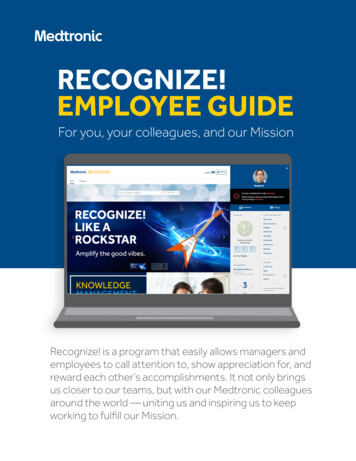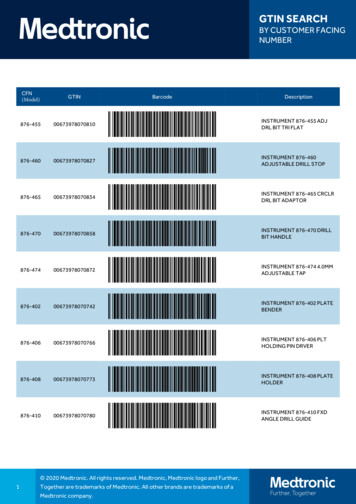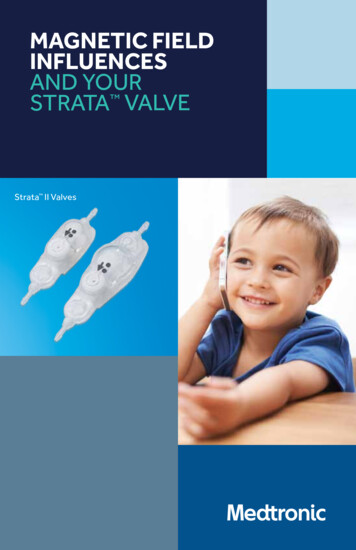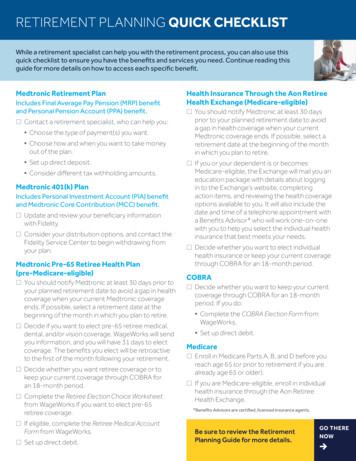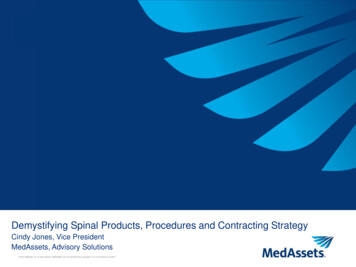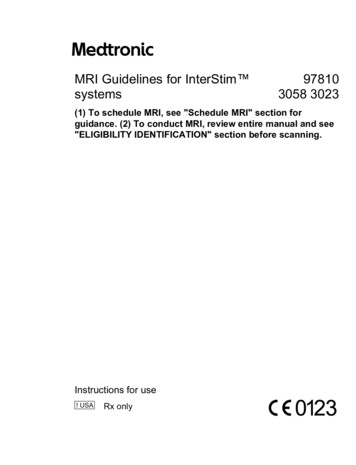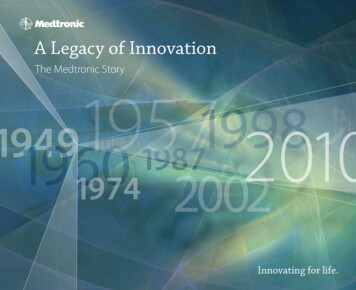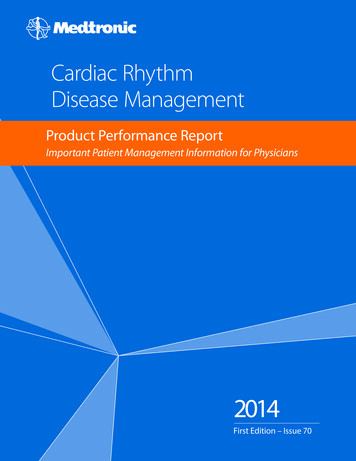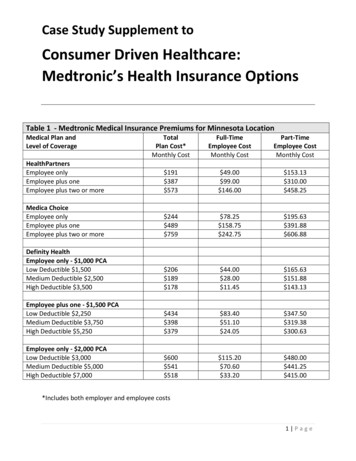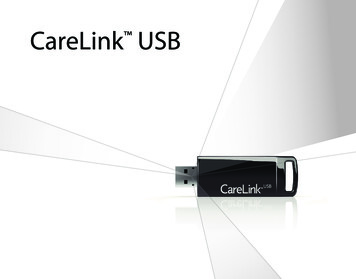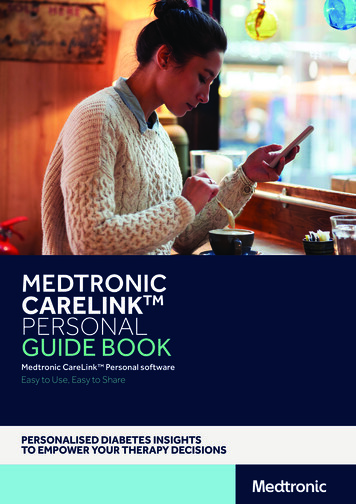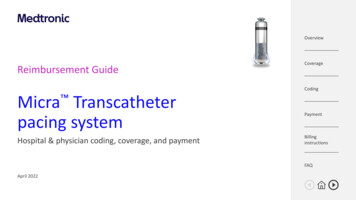
Transcription
OverviewReimbursement Guide MicraTranscatheterpacing systemHospital & physician coding, coverage, and April 2022
Hospital & physician reimbursement guideFor the Micra Transcatheter pacing systemThis guide has been developed to help you understand Medicare coverage, coding,and payment for transcatheter pacemaker procedures.Please contact Reimbursement Customer Support for further information:OverviewCoverageWebsite: http://www.medtronic.com/crhfreimbursementPhone: 866-877-4102 (M–F, 8:00 a.m. to 5:00 p.m. CT)Email: erMedtronic provides this information for your convenience only. It does not constitute legal advice or a recommendationregarding clinical practice. Information provided is gathered from third-party sources and is subject to change without noticedue to frequently changing laws, rules, and regulations. The provider has the responsibility to determine medical necessity andto submit appropriate codes and charges for care provided. Medtronic makes no guarantee that the use of this information will prevent differencesof opinion or disputes with Medicare or other payers as to the correct form of billing or the amount that willbe paid to providers of service. Please contact your Medicare contractor, other payers, reimbursement specialists, and/or legal counsel for interpretation of coding,coverage and payment policies. This document provides assistance for FDA approvedor cleared indications. Where reimbursement is sought for use of a product that may be inconsistent with, or not expressly specified in, the FDA cleared or approvedlabeling (e.g., instructions for use, operator’s manual or package insert), consultwith your billing advisors or payers on handling such billing issues. Some payers may have policies that make it inappropriateto submit claims for such items or related service.CPT copyright 2021 American Medical Association. All rights reserved. CPT is a registered trademark of the American Medical Association. Applicable FARS/DFARSrestrictions apply to government use. Fee schedules, relative value units, conversion factors and/or related components are not assigned by the AMA, are not part of CPT,and the AMA is not recommending their use. The AMA does not directly or indirectly practice medicine or dispense medical services. The AMA assumes no liability for thedata contained or not contained herein.2PaymentBillinginstructionsFAQ
Table of contentsOverview of the Micra transcatheter pacing systemsCoverage for leadless pacemaker therapy Medicare national coverage determination criteria for leadless pacemakers Medicare advantage coverage Coverage with non-Medicare payersCoding for leadless pacemaker therapy CPT codes HCPCS codes (C-codes) ICD-10-PCS procedure codes ICD-10-CM diagnosis codesPayment for leadless pacemaker therapy Physician coding and payment Hospital outpatient payment Hospital inpatient paymentBilling instructions Medicare Medicare advantage payers Non-Medicare payersFrequently asked overageCodingPaymentBillinginstructionsFAQ
Overview of the Micra Transcatheter pacing systemsOverviewBrief backgroundThe Micra Transcatheter Pacing System (TPS) is theworld’s smallest pacemaker, 93% smaller than traditionalpacemakers.1 It is delivered percutaneously via a minimallyinvasive approach, directly into the right ventricle withoutthe use of leads.Leadless pacemakers, also known as intracardiac ortranscatheter pacemakers, are pacemakers in which thelead(s) and generator are combined into a single deviceimplanted directly within the heart, without anysubcutaneous pocket or tunneling.This contrasts with traditional transvenous pacemakersthat require implant of a subcutaneous generator plustransvenous/epicardial lead(s).Leadless pacemakerdevice descriptionsThe original Micra pacing system, referred to in thisdocument as the Micra VR device,* is a single-chamberpacemaker pacing the ventricle.The Micra AV device extends leadless pacing to AV Blockonly patients, including a portion of patients who mayhave traditionally received adual-chamber transvenous pacing system.This technology has the unique ability to sense mechanicalatrial activity, allowing the device to provide AVsynchronous ventricular pacing to indicated patients.2 TheMicra AV device is the same size and maintains the samestreamlined implant procedure as the Micra VR *The single chamber Micra Transcatheter Pacing System is being described herein as Micra VR in order to distinguish it from the Micra AV product. When information in this document relates to both Micra AV and VR, “Micra Transcatheter Pacing Systems” is used to represent the portfolio of devices.4
FDA–approved indicationsNot every Micra TPS model is approved for allindications; please see the product labeling3 forindication details:Paroxysmal or permanent high-grade AV block in the presence of AFThe Micra TPSis FDA-approved for patientswho have experienced one ormore of the followingconditions.OverviewCoverageParoxysmal or permanent high-grade AV block in the absence of AF, as an alternative to dualchamber pacing, when a dual-chamber transvenous pacing system is considered difficult,high risk, or not deemed necessary foreffective therapyCodingSymptomatic bradycardia-tachycardia syndrome or sinus node dysfunction(sinus bradycardia or sinus pauses), as an alternative to atrial or dual chamber pacing, whena dual-chamber transvenous pacing system is considered difficult, high risk, or not deemednecessary for effective therapyPaymentThe Micra AV device is also indicated for VDD pacing in patients with adequate sinus rates who may benefit frommaintenance of AV synchrony.BillinginstructionsThe Micra AV device provides AV synchronous ventricular pacing similar to a transvenous VDD system. The implanted devicedepends on the appropriate sensing of atrial mechanical signals to achieve AV synchrony. The level of AV synchrony may varyin individual patients and may not be predictable prior to implant.Rate-responsive pacing is indicated to provide increased heart rate appropriate to increasing levels of activity. The device isdesigned to be used only in the right ventricle.5FAQ
Coverage for leadless pacemaker therapyOverviewMedicare national coverage determination criteria for leadless pacemakers4Medicare has a national coverage determination (NCD) designating coverage for leadless pacemakers. This NCD applies to all leadlesspacemaker systems, including both Micra AV and Micra VR devices and can be found in Section 20.8.4 of the Medicare NCD Manual.4Under the NCD, Medicare covers leadless pacemakers through coverage with evidence development (CED), which means CMS will providecoverage for leadless pacemakers when procedures are performed as part of an ongoing, CMS-approved study and used according to theFDA-labeled indications for the device. CMS does not cover leadless pacemakers outside of CMS-approved studies.5,6A current copy of the CMS NCD as well as any related policy articles can be found on the CMS NCD website.5CoverageCodingMicra CED studies approved by CMS for coverageCED studies for both the Micra AV and the Micra VR devices are approved by CMS for purposes of coverage under the NCD, and are postedon the CMS CED website.7,8 These claims-based studies, in which Medicare beneficiaries receiving leadless pacemakers with Micra devicesare automatically enrolled through standard billing practices, satisfy the basis for coverage and enable Medicare reimbursement.6DeviceModel #Study nameNCT #Micra VR systemMC1VR01Micra CED study03039712Micra AV systemMC1AVR1Micra AV CED study04235491PaymentBillinginstructionsFAQ
All Medicare patients who undergo a Micra implantation procedure in the U.S. will be automaticallyincluded in the CED Study specific to the Micra Systemimplanted as described in the table on the previouspage.These studies use retrospective Medicare claimsanalyses to study patient outcomes, so there is noactive data collection from individual hospitals.Claims for the analysis are identified by CPT codesand ICD-10 diagnosis and procedure codes andmust adhere to the billing requirements fromMedicare to meet the coverage criteria.9,10Details can be found in the Billing Instructionssection of this document.In addition, the Micra VR and Micra AV CEDstudies have received central IRB approval, so IRBapproval at individual hospitals is not necessary.The clinicaltrials.gov registration providesstudy descriptions for the Micra AV andMicra VR CED studies.7,87Medicare Advantage coverageMedicare NCDs apply to both traditional Medicare and MedicareAdvantage plans, whether administered directly by CMS or bycommercial Medicare Advantage plans. The Medicare Managed CareManual establishes that Medicare Advantage plans are subject to thesame coverage requirements as traditional Medicare for NCD requiringCED, such as the Micra CED studies as described above.11 Priorauthorization for Micra TPS insertion procedures may be required fromsome commercial insurers to determine the applicability of coveredbenefits for a specific patient case. We recommend that you contact yourpatient’s Medicare Advantage plan for information on any additionalclaims processing requirements that may be applicable to your MedicareAdvantage patients.Coverage with non-Medicare payersNon-Medicare payers typically determine coverage for procedures basedon coverage policies and prior authorization. Medtronic recommendsthat you review the specific payer coverage policies applicable to yourpatient to verify all the criteria for coverage are met. Not all publishedpolicies apply to all patients covered by a particular payer. Werecommend that you check for any applicable coverage policy andcontact the payer to obtain a prior authorization or prior approval. Askingabout coverage after an implant procedure may result in unpaid claims,leaving both the hospital and the physicianwithout compensation.For additional information regarding the prior authorization process, please refer toour Coverage and Prior Authorization Information document onsFAQ
Coding for leadless pacemaker therapyThe coding information below is for information only and does not replace seeking coding advice fromthe payer and/or your own coding staff. The ultimate responsibility for correct coding lies with theprovider of services. All diagnosis and procedure codes must be supported by clear documentationwithin the medical record.12OverviewCoverageCodingCPT CodesThe following CPT 13 codes describe procedures associated with leadless pacemaker therapy.Documentation will dictate the appropriate coding. These codes may be used by physicians in anysetting and may be used by facilities when services are rendered in the outpatient hospital orambulatory surgery center setting.It is the physician’s discretion as to what codes to report based on what procedures were performedand documented.PaymentBillinginstructionsFAQ8
CPT code13CPT code description13Insertion or removal of leadless pacemaker33274Transcatheter insertion or replacement of permanent leadless pacemaker, right ventricular, including imaging guidance(e.g., fluoroscopy, venous ultrasound, ventriculography, femoral venography) and device evaluation (e.g., interrogation orprogramming), when performed33275Transcatheter removal of permanent leadless pacemaker, right ventricular, including imaging guidance (e.g., fluoroscopy, venousultrasound, ventriculography, femoral ventriculography), when performedCoverageIn-person monitoring93279OverviewProgramming device evaluation (in person) with iterative adjustment of the implantable device to test the function of the device andselect optimal permanent programmed values with analysis, review and report by a physician or other qualified health careprofessional; single lead pacemaker system or leadless pacemaker system in one cardiac chamber93286Peri-procedural device evaluation (in person) and programming of device system parameters before or after a surgery, procedure, ortest with analysis, review and report by a physician or other qualified health care professional; single, dual, or multiple leadpacemaker system, or leadless pacemaker system93288Interrogation device evaluation (in person) with analysis, review and report by a physician or other qualified health care professional,includes connection, recording and disconnection per patient encounter; single, dual, or multiple lead pacemaker system, or leadlesspacemaker systemCodingPaymentRemote monitoring93294Interrogation device evaluation, remote, up to 90 days, single, dual, or multiple lead pacemaker system, or leadless pacemaker systemwith interim analysis, review(s) and report(s) by a physician or other qualified health care professional93296Interrogation device evaluation, remote, up to 90 days, single, dual, or multiple lead pacemaker system, leadless pacemaker system,or implantable defibrillator system, remote data acquisition(s), receipt of transmissions and technician review, technical support anddistribution of resultsMedicare policy requires specific additional information on claims. See billing instructions section (pages 19-23) here.9BillinginstructionsFAQ
HCPCS codes (C-codes)Medicare provides deviceC-codes for hospital use inbilling Medicare for medicaldevices in the outpatientsetting.14 The following HCPCScodes relate to the implantationof leadless pacemaker services.HCPCS codeHCPCS code descriptionC1786Pacemaker, single chamber, rate-responsive (implantable)C1894Introducer/sheath, other than guiding, other than intracardiac electrophysiological, nonlaserOverviewCoverageICD-10-PCS procedure codesHospitals assign ICD-10-PCS codes for procedures performed during an inpatient admission. Thefollowing ICD-10-PCS codes describe commonly performed leadless pacemaker procedures.ICD-10-PCS code15ICD-10-PCS code descriptionInsertion of leadless pacemaker02HK3NZCodingPaymentInsertion of intracardiac pacemaker into right ventricle, percutaneous approachRevision of leadless pacemaker02WA3NZOne or more of the followingcodes may be appropriatedepending on the componentsused in the associatedprocedure:Revision of intracardiac pacemaker in heart, percutaneous approachRemoval of leadless pacemaker02PA3NZRemoval of intracardiac pacemaker from heart, percutaneous approachRemoval and replacement of leadless pacemaker02PA3NZand 02HK3NZRemoval of intracardiac pacemaker from heart, percutaneous approach; and insertion of intracardiacpacemaker into right ventricle, percutaneous approachMedicare policy requires specific additional information on claims. See billing instructions section (pages 19-23) here.10BillinginstructionsFAQ
ICD-10-CM diagnosis codesHospitals and other providers assign ICD-10-CM codes to indicate a patient’s diagnosis or clinical status. The following is a list ofexamples of possible ICD-10-CM diagnosis codes that may relate to indications associated with leadless pacemaker procedures.This is not an all-inclusive list and the diagnosis codes reported should be based on documentation appropriate to individualpatient presentation.OverviewCoverageICD-10-CM diagnosis code16ICD-10-CM diagnosis code descriptionPrimary (Principal) diagnosisI44.1Atrioventricular block, second degreeI44.2Atrioventricular block, completeI49.5Sick sinus syndrome (Tachy-brady syndrome)Q24.6Congenital heart blockCodingPaymentSecondary diagnosisZ00.6Encounter for examination for normal comparison and control in clinical research programBillinginstructionsTertiary diagnosis (Used only if applicable)I48.0Paroxysmal atrial fibrillationI48.1Persistent atrial fibrillationI48.2Chronic atrial fibrillation11FAQ
Payment for leadless pacemaker therapyThe following information reflects the Medicare national allowable amount published by CMSand does not include Medicare payment reductions resulting from sequestration adjustments to the amountpayable to the provider, as mandated by the Budget Control Act of 2011.The Medtronic Customer Economics and Reimbursement teams can provide site-specific informationupon request.OverviewCoverageCodingPhysician paymentEffective January 1, 2022–December 31, 202217Physicians use CPT codes to represent procedures and services performed in all placesof service. Under Medicare’s methodology for physician payment, each CPT code is assigned a value,known as relative value units (RVUs). RVUs are part of how Medicare determines a payment amount.RVUs are then converted to a flat payment amount.PaymentBillinginstructionsFAQ12
MedicareTotal RVUsMedicare nationalUnadjusted rate17For physician services provided cemakerdeviceprogrammingin ty33274Transcatheter insertion or replacement of permanent leadlesspacemaker, right ventricular, including imaging guidance (e.g.,fluoroscopy, venous ultrasound, ventriculography, femoral venography)and device evaluation (e.g., interrogation or programming),when performedN/A14.26N/A 49333275Transcatheter removal of permanent leadless pacemaker, rightventricular, including imaging guidance (e.g., fluoroscopy, venousultrasound, ventriculography, femoral ventriculography), when performedN/A14.85N/A 5142.05N/A 71N/ACPT onin person93288TC9328826CPT descriptionProgramming device evaluation (in person) with iterative adjustment ofthe implantable device to test the function of the device and selectoptimal permanent programmed values with analysis, review and reportby a physician or other qualified health care professional; single leadpacemaker system or leadless pacemaker system in one cardiac chamberInterrogation device evaluation (in person) with analysis, review andreport by a physician or other qualified health care professional, includesconnection, recording and disconnection per patient encounter; single,dual, or multiple lead pacemaker system, or leadless pacemaker system1.13N/A 39N/A0.920.92 32 321.73N/A 60N/A1.12N/A 39N/A0.610.61 21 21Medicare policy requires specific additional information on claims. See billing instructions section (pages 19-23) tionsFAQ
MedicareTotal RVUsMedicare nationalUnadjusted rate17For physician services provided Facility1.42N/A 49N/A0.98N/A 34N/A0.440.44 15 1593294Interrogation device evaluation(s) (remote), up to 90 days; single, dual,or multiple lead pacemaker system, or leadless pacemaker system withinterim analysis, review(s) and report(s) by a physician or other qualifiedhealth care professional0.880.88 30 30Billinginstructions93296Interrogation device evaluation(s) (remote), up to 90 days; single, dual,or multiple lead pacemaker system, leadless pacemaker system, orimplantable defibrillator system, remote data acquisition(s), receipt oftransmissions and technician review, technical support and distributionof results0.69N/A 24N/AFAQCPT code13ModCPT rviewPeri-procedural device evaluation (in person) and programming of devicesystem parameters before or after a surgery, procedure, or test withanalysis, review and report by a physician or other qualified health careprofessional; single, dual, or multiple lead pacemaker system, or leadlesspacemaker systemCoverageCodingPayment
Hospital outpatient paymentOverviewEffective January 1, 2022–December 31, 202218The following CPT 13 codes describe procedures associated with Leadless Pacemaker Therapy. These codes may be reported by facilities whenservices are rendered in the outpatient hospital or ambulatory surgery center setting, when supported by documented medical necessity.Under Medicare’s Ambulatory Payment Classification (APC) methodology for hospital outpatient payment, each CPT code is assigned to anambulatory payment class. Each APC has a relative weight that is then converted to a flat payment amount.CPT code13CPT ativeweight182022Medicare nationalunadjusted rate18Leadless permanent pacemaker procedures3327433275Transcatheter insertion or replacement of permanentleadless pacemaker, right ventricular, including imagingguidance (e.g., fluoroscopy, venous ultrasound,ventriculography, femoral venography) and deviceevaluation (e.g., interrogation or programming),when performedTranscatheter removal of permanent leadless pacemaker,right ventricular, including imaging guidance (e.g.,fluoroscopy, venous ultrasound, ventriculography, femoralventriculography), when performedCodingPayment51945183Level 4endovascularproceduresJ1Level 3vascularproceduresJ1194.86 16,402BillinginstructionsMedicare policy requires specific additional information on claims. See billing instructions section (pages 19-23) here.15Coverage34.73 2,924FAQ
CPT code13CPT ativeweight182022Medicare nationalunadjusted rate18Pacemaker device programming-in person93279Programming device evaluation (in person) with iterativeadjustment of the implantable device to test the functionof the device and select optimal permanent programmedvalues with analysis, review and report by a physician orother qualified health care professional; single leadpacemaker system or leadless pacemaker system in onecardiac chamberOverview5741Level 1electronicanalysis ofdevicesQ10.45 38Pacemaker device interrogation-in person93288Interrogation device evaluation (in person) with analysis,review and report by a physician or other qualified healthcare professional, includes connection, recording anddisconnection per patient encounter; single, dual, ormultiple lead pacemaker system, or leadless pacemakersystemCoverageCoding5741Level 1electronicanalysis ofdevicesQ10.45 38PaymentBillinginstructionsFAQ16
CPT code13CPT ativeweight182022Medicare nationalunadjusted rate18Peri-procedure device programming; pacemaker93286Peri-procedural device evaluation (in person)and programming of device system parameters before orafter a surgery, procedure, or test with analysis, reviewand report by a physician or other qualified health careprofessional; single, dual, or multiple lead pacemakersystem, or leadless pacemaker systemOverviewN/AN/AN--Pacemaker device evaluation - remote93294Interrogation device evaluation(s) (remote), up to 90 days;single, dual, or multiple lead pacemaker system, orleadless pacemaker system with interim analysis,review(s) and report(s) by a physician or other qualifiedhealth care professional93296Interrogation device evaluation(s) (remote), up to 90 days;single, dual, or multiple lead pacemaker system, leadlesspacemaker system, or implantable defibrillator system,remote data acquisition(s), receipt of transmissions andtechnician review, Technical support and distribution ofresultsCoverageCodingN/AN/A5741Level 1electronicanalysis ofdevicesMQ1-0.45- 38PaymentBillinginstructionsFAQ17
Hospital inpatient paymentOverviewEffective October 1, 2021–September 30, 202219For Medicare, inpatient hospital reimbursement is facilitated through Medicare Severity Diagnosis Related Groups (MS-DRGs).For each admission, the ICD-10 diagnosis and procedure codes are grouped into one of over 750 MS-DRGs. Regardless of the number of codes,only one MS-DRG is assigned to the inpatient hospital admission.If medical necessity criteria are met to support an inpatient admission for the leadless pacemaker procedure the MS-DRG (Medicare SeverityDiagnosis Related Group)20 assignment may be:ICD-10-PCSprocedure codeMS-DRG descriptionCoverageCodingFY2022 MS-DRG Medicarenational unadjusted payment rate19Payment02HK3NZor 02PA3NZor 02WA3NZ228: other cardiothoracic procedures with MCC or229: other cardiothoracic procedures without MCC 35,150 22,692BillinginstructionsMedicare policy requires specific additional information on claims. See billing instructions section (pages 19-23) here.FAQMCC Major Complication or Comorbidity18
Billing instructionsMedicareClick hereOverviewfor Medicare claim requirement examplesThe NCD for Leadless Pacemakers (20.8.4) applies to both traditional Medicare and Medicare Advantage (MA) Plans.4,11 Medicare has publishedCED claims instructions via Medicare Claims Processing Manual 100-04, Transmittal 3815, which instructs billing staff on how to properly submitclaims under NCD 20.8.4.21To facilitate the Medicare claims process, include all the information from the table below, which summarizes the CED billing instructions found inthe Medicare Claims Processing Manual 100-04, Transmittal 3815.21Please review the Claims Processing instructions and CMS Claims Processing Manual 100-04 chapter 32 section 69.6 — Requirements for BillingRoutine Costs of Clinical Trials, and section 380 — Leadless Pacemakers, for the most up-to-date instructions from CMS for billing for routineservices for clinical trials, and for leadless pacemaker services prior to Medicare claims submission.21,2Claims identifying information to signifypatient is participating in a studyNational Clinical Trial (NCT) numberCoverageCodingCED studyMicra VR CED studyNCT03039712Micra AV CED studyPaymentNCT04235491Modifier to category I CPT implant code-Q0 Investigational clinical service provided in a clinical researchstudy that is in an approved clinical research studySecondary diagnosis codeZ00.6 Encounter for examination for normal comparison and control in clinical research programCondition code (facility claims only)3023BillinginstructionsFAQ19qualifying clinical trial
Billing instructionsHospital claimClaims identifying information to signifypatient is participating in a studyOverviewUB-04 form locator hospital claimNCT03039712 or NCT04235491FL 39 Value CodesNational Clinical Trial (NCT) numberCodeAmountD4#######CoverageCodingD4 is reported in the Code field. The NCT number, without the “NCT” prefix is reported in theAmount field. This will be either “03039712” for patients with a Micra VR device or “04235491”for patients with a Micra AV deviceModifier to CPT code on hospital outpatient claimModifier to category I CPT implant code-Q0Investigational clinical service provided in a clinical research study that is in an approved clinicalresearch studySecondary diagnosis code area of UB-04 Z00.6Secondary diagnosis codeEncounter for examination for normal comparison and control in clinicalresearch programCondition code (facility claims only)3023 qualifying clinical trial FL1820PaymentBillinginstructionsFAQ
Billing instructionsPhysician claimClaims identifying information to signifypatient is participating in a studyNational Clinical Trial (NCT) numberCMS 1500 form locator physicianclaim; paperNCT03039712 for Micra VR device NCT04235491 forMicra AV deviceThe NCT number is reported in item 23CMS 1500 form locator physicianclaim; electronicMicra NCT03039712 forVR device NCT04235491 for Micra AV deviceThe NCT number is reported in the electronicequivalent of item 23OverviewCoverageCodingModifier to category I CPT implant code-Q0Investigational clinical service provided in a clinicalresearch study that is in an approved clinical researchstudy-Q0Investigational clinical service provided in a clinicalresearch study that is in an approved clinical researchstudyPaymentBillinginstructionsSecondary diagnosis code21Z00.6Encounter for examination for normal comparison andcontrol in clinicalresearch programZ00.6Encounter for examination for normal comparison andcontrol in clinicalresearch programFAQ
Billing instructionsMedicare Advantage payersOverviewAs noted earlier,Medicare NCDs apply to bothtraditional Medicare andMedicare Advantage plans.The Medicare Managed CareManual establishes thatMedicare Advantage plansare subject to the samecoverage requirements astraditional Medicare forNCDs requiring CED.1122Scan for moreinformation fromCMS on MedicareAdvantageMedicare Advantage plansmay have specific instructions requiring the specification ofthe NCT for proper billing. In addition, prior authorization forMicra TPS insertion procedures may be required fromMedicare Advantage plans to determine the applicability ofcovered benefits for a specific patient case. We recommendyou contact your patient’s Medicare Advantage plan forinformation on any claims processing requirements that maybe applicable to your Medicare Advantage AQ
Billing instructionsNon-Medicare payersOverviewCoverageImportantProviders should confirm coverage with the payer prior to implanting Micra TPS in apatient with commercial insurance. Consult the specific payer coverage policy todetermine requirements for coverage and any specific billing instructions, ifapplicable.For additional information on private payer coverage, review our FAQ for Micra TPS U.S. private payerauthorization.Click here to learn more23CodingPaymentBillinginstructionsFAQ
Frequently asked questions01OverviewHow do I know which Micra CED Study a specific patient is in?The study is based on which device the patient receives. Leadless pacemaker procedures performed according to FDA indications are eligible forMedicare coverage and reimbursement.DeviceModel numberCoverageNCT numberCodingMicra VRMC1VR0103039712PaymentMicra AVMC1AVR104235491BillinginstructionsFAQ24
Frequently asked questions02OverviewIs my hospital considered to be engaged in research because of the Micra CED Study protocols?No. The study involves data collection through CMS standard billing processes for CED studies. Hospitals are not considered a party to theresearch and are not required to obtain individual IRB approval. Medtronic and CMS are part
CPT code 13 CPT code description 13. Insertion or removal of leadless pacemaker. . Programming device evaluation (in person) with iterative adjustment of the implantable device to test the function of the dev ice and select optimal permanent programmed values with analysis, review and report by a physician or other qualified health care .
